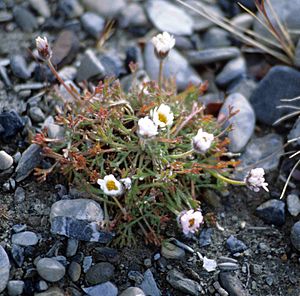Entire-leaved daisy facts for kids
Quick facts for kids Entire-leaved daisy |
|
|---|---|
 |
|
| Quttinirpaaq National Park, Nunavut | |
| Scientific classification | |
| Kingdom: | |
| (unranked): | |
| (unranked): | |
| (unranked): | |
| Order: | |
| Family: | |
| Tribe: |
Anthemideae
|
| Genus: |
Arctanthemum
|
| Species: |
A. integrifolium
|
| Binomial name | |
| Arctanthemum integrifolium (Richardson) Tzvelev 1985
|
|
| Synonyms | |
|
|
Arctanthemum integrifolium, also known as the entire-leaved daisy, is a cool plant that grows in very cold places. It's part of the sunflower family, which means it's related to sunflowers and daisies you might see in your garden! You can find this special daisy in places like Alaska, northern Canada, Peary Land in northern Greenland, and the eastern Chukotka area of Russia. It's a tough little plant that loves the chilly weather of the subarctic.
What it Looks Like
The entire-leaved daisy is a small plant, usually no taller than 12 cm (4.7 in) (about 5 inches). It's a perennial herb, which means it lives for more than two years and doesn't die after flowering. It has a tough, woody stem underground called a caudex. This helps it survive cold winters.
The plant also has a group of leaves at its base that form a circle, like a rosette. Each plant usually grows just one flower. This flower blooms in the summer. It has 11 to 19 white petals, which are called ray flowers. In the center, there are 60 to 80 tiny yellow flowers, known as disc flowers.
Where it Lives
This plant grows in very cold, high-up areas called alpine zones. It also thrives in the arctic tundra. You'll often find it in places with lots of rocks, sand, or gravel. It likes areas where the soil doesn't have much organic material. The entire-leaved daisy does not grow well near the sea or in places with salty air.

